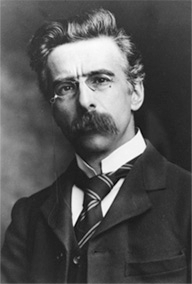
A massive global healthcare problem, solved with one of the most dangerous substances known to mankind… No, it’s not another one of my scripts to be turned down by the bigshots of Hollywood, but the next in our series of British and Irish inventors! (You can see previous editions here!)
Well, it’s often big, bold thinking that causes us to leap forward in technology terms and that’s exactly what Irishman John Joly did, with the invention of radiotherapy.
As well as sporting one of the best moustaches ever seen in modern science, the geologist was also made famous for calculating the age of the Earth through radioactive elements.
He was known for thinking well outside the box – and in 1899 was bold enough to suggest he could predict how old the Earth was by examining sodium levels in the oceans.
Although this work had to be updated later, he stepped above the parapet and this new thinking radically modified other methods used at the time.
Chasing the same goal, he proposed a new theory in 1903 that suggested radium could be used to date the Earth instead. By studying the Earth’s crust, he would later also formulate theories around the geological cycles of the planet.
There was no stopping him there. A decade later, Joly proposed we could use radioactive decay in minerals to calculate that the Devonian period could be no less than 400 million years old. Yep I had to Google that one too – still impressive though!
In 1914, Joly developed a way of extracting radium and applied it to the treatment of cancer. His pioneering ‘Dublin method’, which he developed in collaboration with Walter Stevenson, would treat patients using a hollow needle in deep radiotherapy.
By trade, Joly was a geologist, but he had created something that would change the way cancer was treated for the next century globally.
In the UK, the NHS itself was borne from the same spirit of big thinking, and jumping to the present, it’s fair to say that difficult times are ahead. Demand for services has reached such a scale that Accident & Emergencies were stretched to breaking point last winter, but will technology hold the answer?
You just have to look at the potential benefits from digitisation to realise this is the case.
Being able to connect sensors to just about anything, anyone and any process, along with the growth of wearable technology will mean the combination of information and people will help improve every aspect of healthcare. It will allow for better treatment, as well as letting doctors deliver care at lower costs.
Monitoring patients from any location will reduce the need for people to come into hospitals, saving valuable bed space. It means some patients could be monitored and treated from the comfort of their own home.
Wearable technology could also act as an ‘early warning’ system for GPs. Data on exercise and diets could be collected and collated, flagging any potential problems on the horizon. I better put down the double cheeseburger…
This use of tech also has a knock-on effect on insurance, with cheaper premiums for people following ‘healthier’ lifestyles. I best get back on my bike then.
Like most things, I draw my inspiration from Star Wars. Rather than Jedi mind tricks, it’s droid doctors I’m interested in (this time at least). The next wave of digitisation in healthcare will give us automation where it matters so that the personal touch can be delivered where it’s needed.
Ok we might be a few years off R2-D2 giving you your blood results but a man can dream!
1 Comments



Not only did John Joly pioneer the use of radioactivity as you describe, he also worked out how tall trees draw up water (with H.H. Dixon, my grandfather) and invented an early form of colour photography!